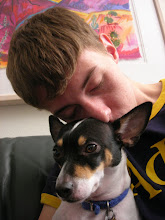 But I'm here for you, right? Yeah.
But I'm here for you, right? Yeah.So today's news isn't really news at all; however, I'm going to guess that the average person on the street has not heard of this problematic species and their interesting behaviors. I've been putting this one off for a while - there's a lot of information, but I think you will find it very intriguing!
Residing in the Southern USA & Mexico, brown-headed cowbirds (Molothrus ater) are obligate brood parasites (some male BHCs pictured on the right in a trap described later). This terminology means that females BHCs do not (and cannot, I assume) construct nests and must lay their eggs in the nest of another species of bird in order to have a successful clutch. The cowbird eggs hatch earlier than the 'normal' eggs and yield large chicks with very big mouths to feed. Guess who's the bad guy here:
For species that "live life on the edge" (sorry, I had to), life is good. For the affected species... not so much. Problems arise when this brood parasitism spells certain death for the nest fate (i.e., success) of, say, endangered species. Brown-headed cowbirds, which used to have a more limited range (and then restricted to edge habitats), must now be controlled in areas under management for endangered species of birds.
A classic example of this BHC control is performed on Fort Hood in central Texas. Fort Hood has been a leader in environmental protection and the protection of endangered species. Many an environmental/biological researcher has earned his or her Ph.D. working on their property - and with good reason. Specifically, Fort Hood is the largest remaining breeding ground for the endangered species of bird, the Black-Capped Vireo. Before controlling for BHC, vireo nest fate was zilch - guaranteed zero percent nest success if parasitized by BHC. Now, the military facility invests a lot of time (and money) into maintaining brown-headed cowbird traps like this one (this is actually a photo I took out at Fort Hood this year):
The premise is simple. The birds can get in, but not out. A door allows someone to enter the cage and handle the birds as necessary. Food and water is provided. Generally, when one BHC is inside the cage (bait), other BHCs will fly over and into the cage to investigate, trapping themselves. Females are euthanized and males are released (only females lay eggs). This simple, if labor-intensive, control has had a hugely positive impact on restoring the black-capped vireo population. The numbers are a bit fuzzy, but I think in the late 80s, Fort Hood had around eighty nesting pairs, and at current they have around five thousand nesting pairs.
So what's new? If you're any sort of bird person, you've probably heard all of the above, if not for the details. The story here is a study released by the University of Florida in 2007 which gave evidence for mafia behavior in female brown-headed cowbirds. ScienceDaily reports on the article (found here). If all of the behavior described above wasn't enough to make you have a distaste for brood parasitism, this article may be the kicker for you. What the researchers, including primary author Jeff Hoover, found was that female brown-headed cowbirds would ransack the nests of birds who rejected the parasitic eggs laid in their nests. It's worth noting that female BHC lay eggs in a nest over a period of days (2-4?), and so they are involved in some parental care of their young - watching to ensure the nest isn't abandoned, checking to see that the eggs have not been pushed out of the nest, and even feeding the chicks after hatching.
Hoover et al. observed Prothonotary warbler nests (a truly beautiful bird which accept BHC eggs almost 100% of the time) and found several interesting things:
The researchers also found what they called "farming behavior." This means that after a warbler rejected the female BHCs eggs, the BHC would force the female warbler to make a new nest, sync her egg laying with the warbler, and parasitize this new nest. This final step happened 85% of the time the farming behaviors were observed. A male prothonotary warbler is pictured on the right (photo credit)."Retaliatory mafia behavior in cowbirds makes hosts' acceptance of cowbird eggs a better proposition than ejection," Hoover said. "The accepting warblers in our study produced more of their own offspring, on average, than those where we ejected cowbird eggs."
I hope you learned something after reading this truly lengthy post. Thanks for sticking it to the end.
 Subscribe
Subscribe




1 comments:
When I first started teaching in east Salinas, California (Steinbeck Country) 23 years ago I became acquainted with a brownheaded cowbird who became our classroom pet. Every day the bird would come by the classroom which was one of those portable buildings and hang upside down outside the back window which looked out on a beautiful lawn and three fir trees. We called him Loco Bird because he would just hang there for quite a time before flying off. Do you know anything about this penchant to hang upside down? Cheers, jeannie e.
Post a Comment
Keep it clean.